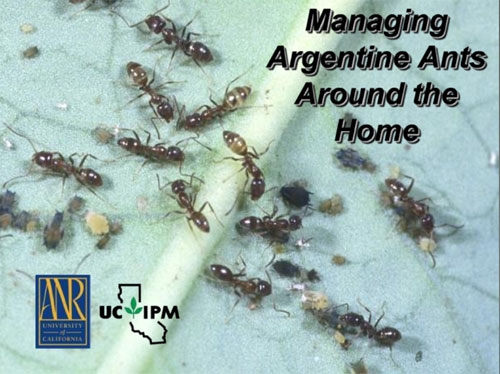Posts Tagged: IPM
UC IPM program is a 2010 'IPM Innovator'
The UC Integrated Pest Management Program is among the organizations to be honored by the California Department of Pesticide Regulation as 2010 "IPM Innovators," according to a DPR news release.
The annual honor is presented to businesses and organizations for their efforts to control insects, weeds, rodents and other pests with a combination of natural and preventive strategies and pesticides less toxic than traditional treatments.
DPR Director Mary-Ann Warmerdam will present the IPM Innovator Awards at 1:30 p.m. tomorrow in the Sierra Hearing Room on the second floor of the California Environmental Protection Agency building in Sacramento.
The UC IPM award is shared with the Natural Resources Conservation Service. The two organizations defined and clarified effective IPM practices for a wide range of commodities and provided stakeholders with this information and incentives to increase their adoption and implementation, the news release said.
Examples of the partnership’s efforts include development of year-round IPM programs for 19 different crops. These programs help to reduce pesticides in water runoff and volatile organic compound pesticide emissions that contribute to smog.
Garden blog features IPM website
The blog "Good Life Garden," developed as part of the UC Davis Robert Mondavi Institute for Wine and Food Science, plugged the UC Statewide Integrated Pest Management website in its most recent "Website Wednesday" feature.
The Good Life Garden itself is an edible landscape in the Mondavi Institute courtyard featuring organic and sustainably grown vegetables, herbs and flowers. Together with the blog of the same name, the garden was designed to educate the public on growing, buying and preparing good tasting and nutritious fresh food.
The blog entry said that last February a pest was found on the bottom of a cabbage leaf. The garden manager turned to the IPM website and found a detailed description that matched the pest, the cabbageworm.
"Voila!" the blog says. "We have a cabbageworm and now know the best way to manage them is by handpicking. Now that was easy!"
The blog also invited readers to post a picture of a pest they can't identify on the Good Life Garden's Facebook page. A question on the page about earwigs refers to an IPM Pest Note on the topic.

Cabbageworm.
UC offers solutions to perennial ant problem
Simple, smart and safe ant invasion solutions from UC Cooperative Extension were shared in newspapers around California today. The article, written by John Sammon, originated in the Santa Cruz Sentinel, and was picked up in the San Gabriel Valley Tribune, the Oakland Tribune, and the Pasadena Star-News.
The reporter used a UC Cooperative Extension information sheet as a source for background on ants. His story focused on the common Argentine variety, small black ants native to Argentina, Brazil, Paraguay and Uruguay. The ants reached the U.S. in the 1890s on coffee ships from Brazil.
In California, Argentine ants displace native ants and the small animals such as lizards that depend on them for food. The article said the ants also harm native plants that depend on native ants for seed dispersal, and they protect insect pests on agricultural crops by driving off species that prey on them, according to the UCCE information sheet.
The article also quoted UCCE Monterey County entomologist Jian Bi, who said homeowners should empty trash and make sure food particles are cleaned and containers tightly closed. In addition, he told the reporter that common household cleaners like Pinesol or Windex can be sprayed on ant trails to make the animals confused or disoriented by removing their scent trail.
"Like people, ants are community-oriented," Bi was quoted. "They're also highly organized."
Sammons collected the following strategies for preventing home ant invasions from home improvement and pest Web sites and UC Cooperative Extension:
-
Empty trash frequently.
-
Make sure food particles are cleaned up, counters wiped and food containers tightly closed.
-
Wash invaded areas with warm soapy water, or spray with a household cleaner to remove ant scent trail. A vinegar and water solution will also work.
-
Eliminate ants' water sources, such as leaks.
-
Caulk and seal cracks and crevices around the home's foundation.
-
Remove leaves, mulch and wood near the foundation of the home.
UC has produced a 20-minute video to help consumers identify, understand and manage Argentine ants. In addition, a diversity of resources - including additional videos, information sheets and photos - on ant management are available on the UC Integrated Pest Management Web site.

The opening screen of the UC IPM video about Argentine ants.
